warning YAMAHA XJ 1300 2015 Owners Manual
[x] Cancel search | Manufacturer: YAMAHA, Model Year: 2015, Model line: XJ 1300, Model: YAMAHA XJ 1300 2015Pages: 98, PDF Size: 2.6 MB
Page 3 of 98
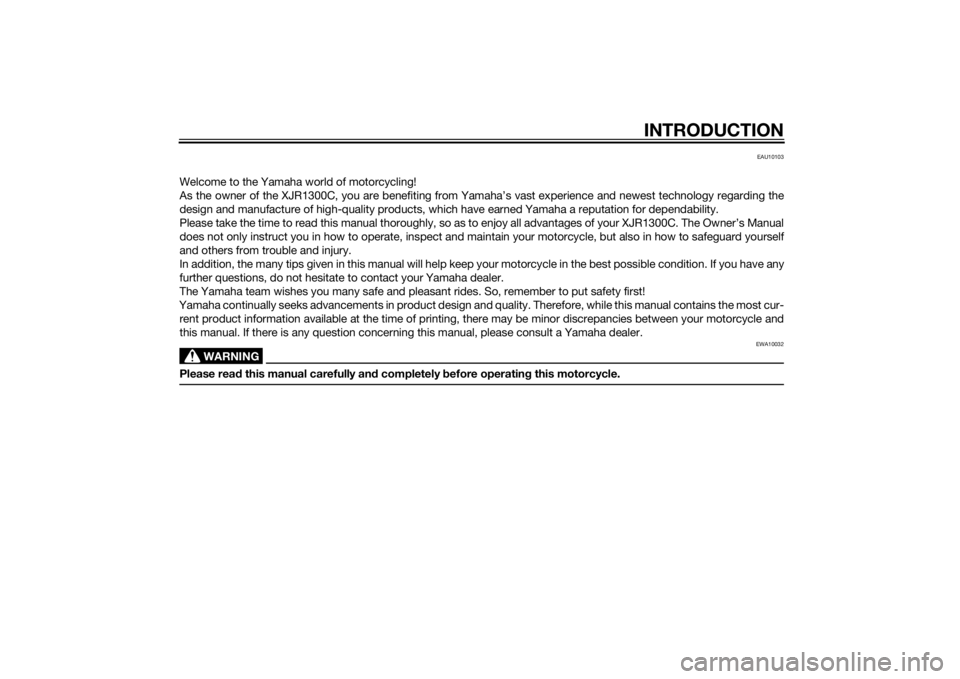
INTRODUCTION
EAU10103
Welcome to the Yamaha world of motorcycling!
As the owner of the XJR1300C, you are benefiting from Yamaha’s vast experience and newest technology regarding the
design and manufacture of high-quality products, which have earned Yamaha a reputation for dependability.
Please take the time to read this manual thoroughly, so as to enjoy all advantages of your XJR1300C. The Owner’s Manual
does not only instruct you in how to operate, inspect and maintain your motorcycle, but also in how to safeguard yourself
and others from trouble and injury.
In addition, the many tips given in this manual will help keep your motorcycle in the best possible condition. If you have any
further questions, do not hesitate to contact your Yamaha dealer.
The Yamaha team wishes you many safe and pleasant rides. So, remember to put safety first!
Yamaha continually seeks advancements in product design and quality. Therefore, while this manual contains the most cur- rent product information available at the time of printing, there may be minor discrepancies between your motorcycle and
this manual. If there is any question concerning this manual, please consult a Yamaha dealer.
WARNING
EWA10032
Please rea d this manual carefully an d completely before operatin g this motorcycle.
U2PNE0E0.book Page 1 Tuesday, September 16, 2014 4:15 PM
Page 4 of 98

IMPORTANT MANUAL INFORMATION
EAU10134
Particularly important information is distinguished in this manual by the following notations:
*Product and specifications are subject to change without notice.This is the safety alert sym
bol. It is use d to alert you to potential personal injury
hazar ds. Ob ey all safety messa ges that follow this sym bol to avoi d possi ble injury
or death.
A WARNING in dicates a hazar dous situation which, if not avoid ed , coul d result in
d eath or serious injury.
A NOTICE in dicates special precautions that must b e taken to avoid d ama ge to the
vehicle or other property.
A TIP provides key information to make procedures easier or clearer.
WARNING
NOTICETIP
U2PNE0E0.book Page 1 Tuesday, September 16, 2014 4:15 PM
Page 6 of 98

TABLE OF CONTENTSSAFETY INFORMATION.................. 1-1
DESCRIPTION .................................. 2-1
Left view ......................................... 2-1
Right view ....................................... 2-2
Controls and instruments ............... 2-3
INSTRUMENT AND CONTROL
FUNCTIONS ...................................... 3-1
Immobilizer system......................... 3-1
Main switch/steering lock............... 3-2
Indicator lights and warning lights............................................ 3-4
Speedometer .................................. 3-5
Tachometer .................................... 3-5
Multi-function display ..................... 3-6
Handlebar switches ........................ 3-9
Clutch lever .................................. 3-10
Shift pedal .................................... 3-11
Brake lever.................................... 3-11
Brake pedal .................................. 3-12
Fuel tank cap ................................ 3-12
Fuel ............................................... 3-13
Fuel tank breather hose and
overflow hose ............................ 3-14
Catalytic converters...................... 3-15
Seat .............................................. 3-15
Adjusting the front fork ................. 3-16
Adjusting the shock absorber
assembly ................................... 3-18
Luggage strap holders ................. 3-21 EXUP system ................................ 3-21
Sidestand ...................................... 3-21
Ignition circuit cut-off system ....... 3-22
FOR YOUR SAFETY –
PRE-OPERATION CHECKS ............. 4-1
OPERATION AND IMPORTANT
RIDING POINTS ................................ 5-1
Starting the engine .......................... 5-1
Shifting ............................................ 5-2
Tips for reducing fuel consumption ................................ 5-3
Engine break-in ............................... 5-3
Parking ............................................ 5-4
PERIODIC MAINTENANCE AND
ADJUSTMENT ................................... 6-1
Owner’s tool kit ............................... 6-2
Periodic maintenance chart for the emission control system .............. 6-3
General maintenance and lubrication chart ........................... 6-4
Removing and installing panels ...... 6-8
Checking the spark plugs ............... 6-9
Engine oil and oil filter element ..... 6-10
Replacing the air filter element and cleaning the check hose..... 6-13
Checking the throttle grip free
play ............................................ 6-15
Valve clearance ............................. 6-15 Tires .............................................. 6-15
Cast wheels .................................. 6-18
Clutch lever................................... 6-18
Checking the brake lever free
play ............................................ 6-18
Brake light switches ..................... 6-19
Checking the front and rear brake pads .......................................... 6-19
Checking the brake and clutch fluid levels.................................. 6-20
Changing the brake and clutch
fluids .......................................... 6-21
Drive chain slack........................... 6-22
Cleaning and lubricating the drive chain.......................................... 6-23
Checking and lubricating the cables ........................................ 6-24
Checking and lubricating the throttle grip and cable ............... 6-24
Checking and lubricating the
brake and shift pedals............... 6-24
Checking and lubricating the brake and clutch levers ............. 6-25
Checking and lubricating the sidestand................................... 6-26
Lubricating the swingarm
pivots......................................... 6-26
Checking the front fork ................. 6-26
Checking the steering................... 6-27
Checking the wheel bearings ....... 6-28
Battery .......................................... 6-28U2PNE0E0.book Page 1 Tuesday, September 16, 2014 4:15 PM
Page 8 of 98

1-1
1
SAFETY INFORMATION
EAU1028B
Be a Responsible Owner
As the vehicle’s owner, you are re-
sponsible for the safe and proper oper-
ation of your motorcycle.
Motorcycles are single-track vehicles.
Their safe use and operation are de-
pendent upon the use of proper riding
techniques as well as the expertise of
the operator. Every operator should
know the following requirements be-
fore riding this motorcycle.
He or she should: Obtain thorough instructions from
a competent source on all aspects
of motorcycle operation.
Observe the warnings and mainte-
nance requirements in this Own-
er’s Manual.
Obtain qualified training in safe
and proper riding techniques.
Obtain professional technical ser-
vice as indicated in this Owner’s
Manual and/or when made neces-
sary by mechanical conditions.
Never operate a motorcycle with-
out proper training or instruction.
Take a training course. Beginners
should receive training from a cer-
tified instructor. Contact an autho-
rized motorcycle dealer to find out
about the training courses nearest
you.
Safe Ri din g
Perform the pre-operation checks
each time you use the vehicle to make
sure it is in safe operating condition.
Failure to inspect or maintain the vehi-
cle properly increases the possibility of
an accident or equipment damage.
See page 4-1 for a list of pre-operation
checks. This motorcycle is designed to
carry the operator and a passen-
ger.
The failure of motorists to detect
and recognize motorcycles in traf-
fic is the predominating cause of
automobile/motorcycle accidents.
Many accidents have been
caused by an automobile driver
who did not see the motorcycle.
Making yourself conspicuous ap- pears to be very effective in reduc-
ing the chance of this type of
accident.
Therefore:
• Wear a brightly colored jacket.
• Use extra caution when you are approaching and passing
through intersections, since in-
tersections are the most likely
places for motorcycle accidents
to occur.
• Ride where other motorists can see you. Avoid riding in another
motorist’s blind spot.
• Never maintain a motorcycle without proper knowledge.
Contact an authorized motorcy-
cle dealer to inform you on ba-
sic motorcycle maintenance.
Certain maintenance can only
be carried out by certified staff.U2PNE0E0.book Page 1 Tuesday, September 16, 2014 4:15 PM
Page 17 of 98
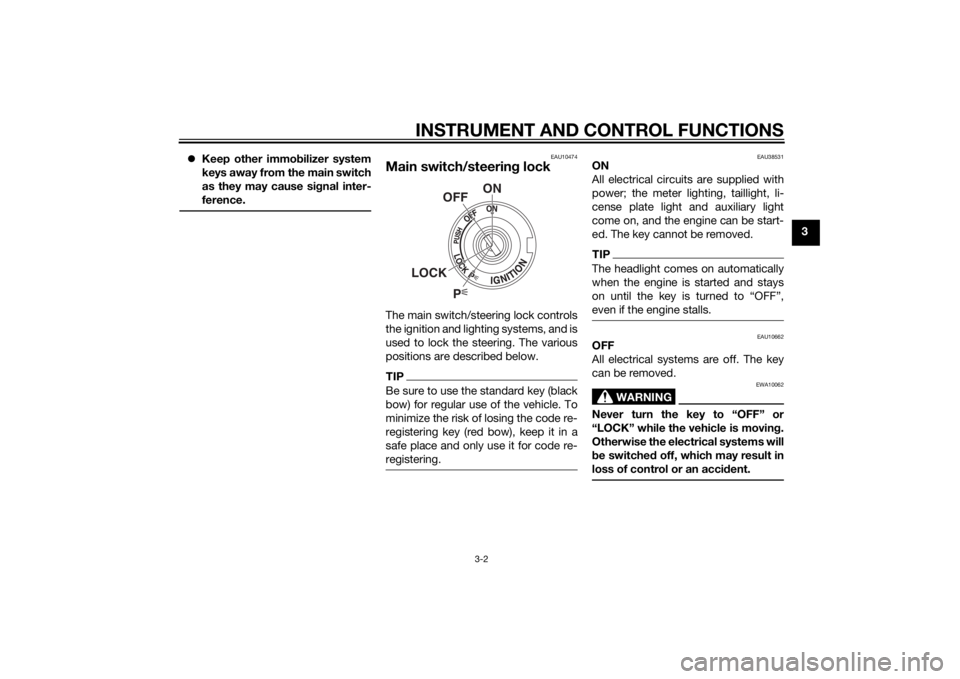
INSTRUMENT AND CONTROL FUNCTIONS
3-2
3
Keep other immo bilizer system
keys away from the main switch
as they may cause si gnal inter-
ference.
EAU10474
Main switch/steerin g lockThe main switch/steering lock controls
the ignition and lighting systems, and is
used to lock the steering. The various
positions are described below.TIPBe sure to use the standard key (black
bow) for regular use of the vehicle. To
minimize the risk of losing the code re-
registering key (red bow), keep it in a
safe place and only use it for code re-
registering.
EAU38531
ON
All electrical circuits are supplied with
power; the meter lighting, taillight, li-
cense plate light and auxiliary light
come on, and the engine can be start-
ed. The key cannot be removed.TIPThe headlight comes on automatically
when the engine is started and stays
on until the key is turned to “OFF”,
even if the engine stalls.
EAU10662
OFF
All electrical systems are off. The key
can be removed.
WARNING
EWA10062
Never turn the key to “OFF” or
“LOCK” while the vehicle is movin g.
Otherwise the electrical systems will
b e switche d off, which may result in
loss of control or an acci dent.
P
ON
OFF
LOCK
U2PNE0E0.book Page 2 Tuesday, September 16, 2014 4:15 PM
Page 19 of 98
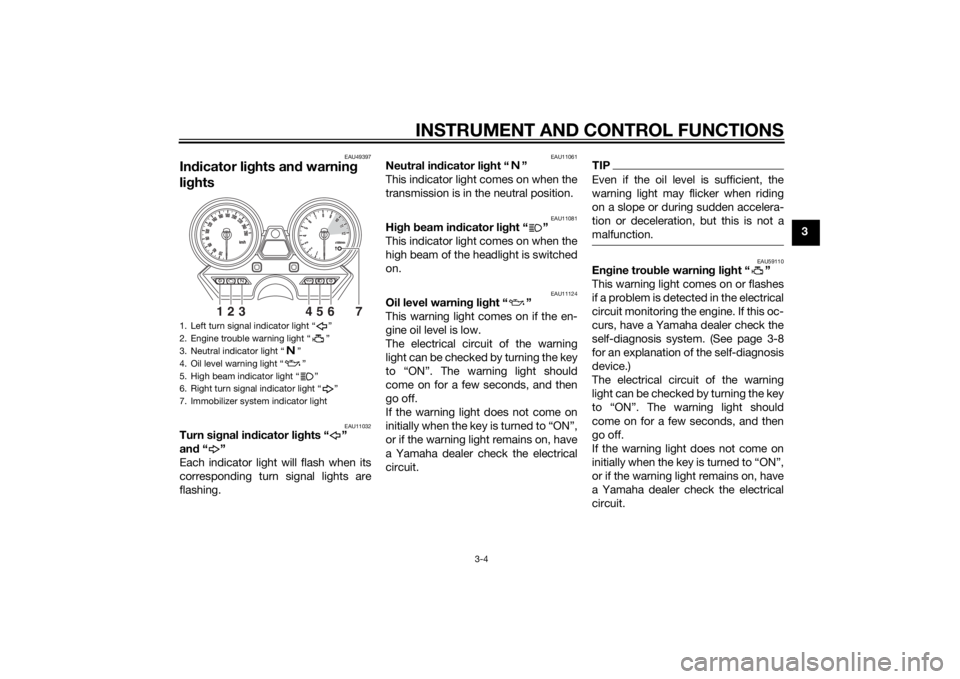
INSTRUMENT AND CONTROL FUNCTIONS
3-4
3
EAU49397
Indicator lig hts and warning
lig hts
EAU11032
Turn si gnal in dicator li ghts “ ”
an d“”
Each indicator light will flash when its
corresponding turn signal lights are
flashing.
EAU11061
Neutral in dicator li ght “ ”
This indicator light comes on when the
transmission is in the neutral position.
EAU11081
Hi gh beam in dicator li ght “ ”
This indicator light comes on when the
high beam of the headlight is switched
on.
EAU11124
Oil level warnin g lig ht “ ”
This warning light comes on if the en-
gine oil level is low.
The electrical circuit of the warning
light can be checked by turning the key
to “ON”. The warning light should
come on for a few seconds, and then
go off.
If the warning light does not come on
initially when the key is turned to “ON”,
or if the warning light remains on, have
a Yamaha dealer check the electrical
circuit.
TIPEven if the oil level is sufficient, the
warning light may flicker when riding
on a slope or during sudden accelera-
tion or deceleration, but this is not a
malfunction.
EAU59110
En gine trou ble warnin g li ght “ ”
This warning light comes on or flashes
if a problem is detected in the electrical
circuit monitoring the engine. If this oc-
curs, have a Yamaha dealer check the
self-diagnosis system. (See page 3-8
for an explanation of the self-diagnosis
device.)
The electrical circuit of the warning
light can be checked by turning the key
to “ON”. The warning light should
come on for a few seconds, and then
go off.
If the warning light does not come on
initially when the key is turned to “ON”,
or if the warning light remains on, have
a Yamaha dealer check the electrical
circuit.
1. Left turn signal indicator light “ ”
2. Engine trouble warning light “ ”
3. Neutral indicator light “ ”
4. Oil level warning light “ ”
5. High beam indicator light “ ”
6. Right turn signal indicator light “ ”
7. Immobilizer system indicator light
123
456
7
U2PNE0E0.book Page 4 Tuesday, September 16, 2014 4:15 PM
Page 20 of 98
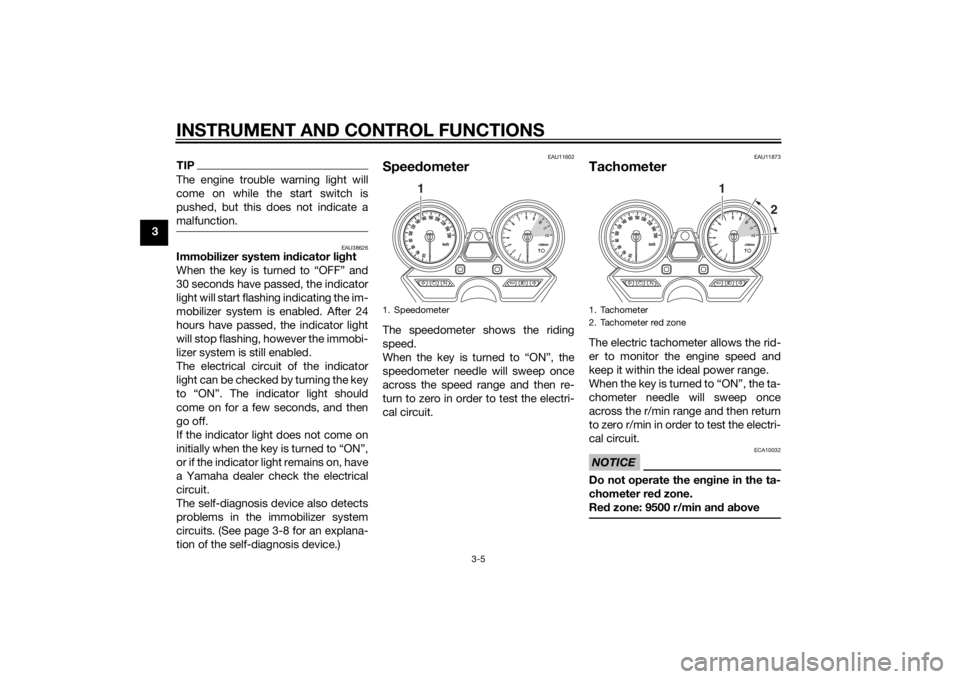
INSTRUMENT AND CONTROL FUNCTIONS
3-5
3
TIPThe engine trouble warning light will
come on while the start switch is
pushed, but this does not indicate a
malfunction.
EAU38626
Immobilizer system in dicator li ght
When the key is turned to “OFF” and
30 seconds have passed, the indicator
light will start flashing indicating the im-
mobilizer system is enabled. After 24
hours have passed, the indicator light
will stop flashing, however the immobi-
lizer system is still enabled.
The electrical circuit of the indicator
light can be checked by turning the key
to “ON”. The indicator light should
come on for a few seconds, and then
go off.
If the indicator light does not come on
initially when the key is turned to “ON”,
or if the indicator light remains on, have
a Yamaha dealer check the electrical
circuit.
The self-diagnosis device also detects
problems in the immobilizer system
circuits. (See page 3-8 for an explana-
tion of the self-diagnosis device.)
EAU11602
Speed ometerThe speedometer shows the riding
speed.
When the key is turned to “ON”, the
speedometer needle will sweep once
across the speed range and then re-
turn to zero in order to test the electri-
cal circuit.
EAU11873
TachometerThe electric tachometer allows the rid-
er to monitor the engine speed and
keep it within the ideal power range.
When the key is turned to “ON”, the ta-
chometer needle will sweep once
across the r/min range and then return
to zero r/min in order to test the electri-
cal circuit.NOTICE
ECA10032
Do not operate the en gine in the ta-
chometer red zone.
Re d zone: 9500 r/min an d a bove
1. Speedometer
1
1. Tachometer
2. Tachometer red zone
1
2
U2PNE0E0.book Page 5 Tuesday, September 16, 2014 4:15 PM
Page 21 of 98
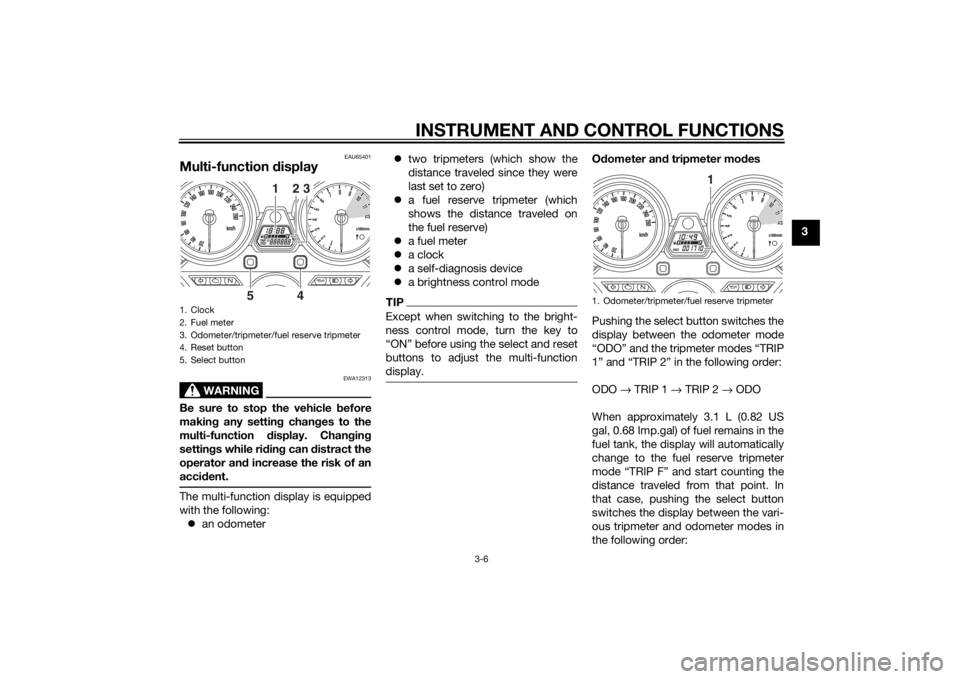
INSTRUMENT AND CONTROL FUNCTIONS
3-6
3
EAU65401
Multi-function display
WARNING
EWA12313
Be sure to stop the vehicle before
makin g any settin g chan ges to the
multi-function display. Chan gin g
settin gs while ri din g can distract the
operator an d increase the risk of an
acci dent.The multi-function display is equipped
with the following:
an odometer
two tripmeters (which show the
distance traveled since they were
last set to zero)
a fuel reserve tripmeter (which
shows the distance traveled on
the fuel reserve)
a fuel meter
a clock
a self-diagnosis device
a brightness control mode
TIPExcept when switching to the bright-
ness control mode, turn the key to
“ON” before using the select and reset
buttons to adjust the multi-function
display.
Odometer an d tripmeter mo des
Pushing the select button switches the
display between the odometer mode
“ODO” and the tripmeter modes “TRIP
1” and “TRIP 2” in the following order:
ODO → TRIP 1 → TRIP 2 → ODO
When approximately 3.1 L (0.82 US
gal, 0.68 Imp.gal) of fuel remains in the
fuel tank, the display will automatically
change to the fuel reserve tripmeter
mode “TRIP F” and start counting the
distance traveled from that point. In
that case, pushing the select button
switches the display between the vari-
ous tripmeter and odometer modes in
the following order:
1. Clock
2. Fuel meter
3. Odometer/tripmeter/fuel reserve tripmeter
4. Reset button
5. Select button
1
23
5
4
1. Odometer/tripmeter/fuel reserve tripmeter
1
U2PNE0E0.book Page 6 Tuesday, September 16, 2014 4:15 PM
Page 22 of 98
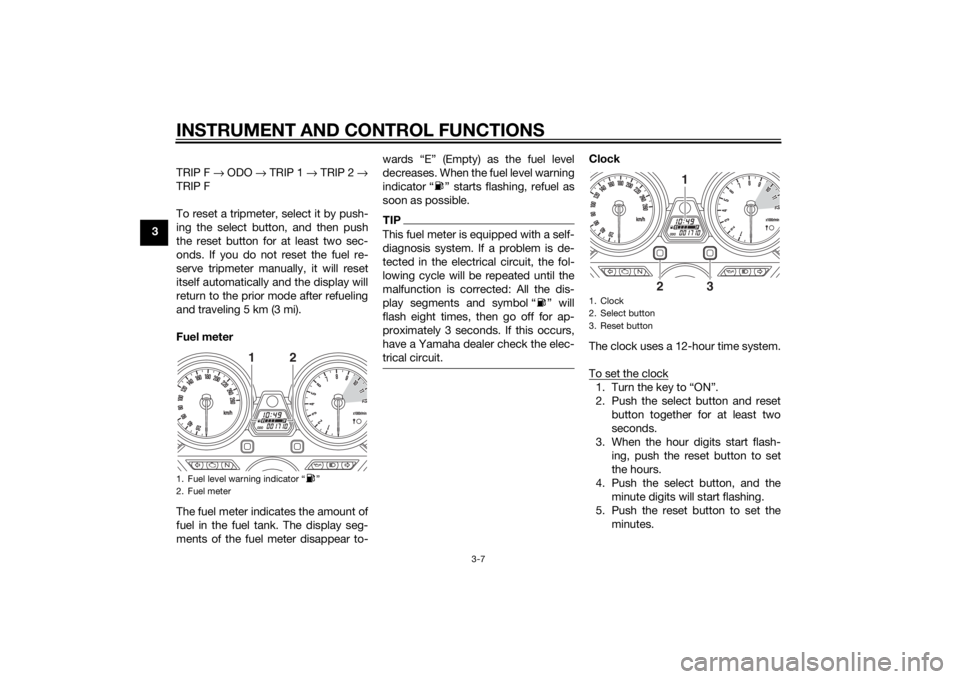
INSTRUMENT AND CONTROL FUNCTIONS
3-7
3TRIP F
→ ODO → TRIP 1 → TRIP 2 →
TRIP F
To reset a tripmeter, select it by push-
ing the select button, and then push
the reset button for at least two sec-
onds. If you do not reset the fuel re-
serve tripmeter manually, it will reset
itself automatically and the display will
return to the prior mode after refueling
and traveling 5 km (3 mi).
Fuel meter
The fuel meter indicates the amount of
fuel in the fuel tank. The display seg-
ments of the fuel meter disappear to- wards “E” (Empty) as the fuel level
decreases. When the fuel level warning
indicator “ ” starts flashing, refuel as
soon as possible.
TIPThis fuel meter is equipped with a self-
diagnosis system. If a problem is de-
tected in the electrical circuit, the fol-
lowing cycle will be repeated until the
malfunction is corrected: All the dis-
play segments and symbol “ ” will
flash eight times, then go off for ap-
proximately 3 seconds. If this occurs,
have a Yamaha dealer check the elec-
trical circuit.
Clock
The clock uses a 12-hour time system.
To set the clock1. Turn the key to “ON”.
2. Push the select button and reset
button together for at least two
seconds.
3. When the hour digits start flash- ing, push the reset button to set
the hours.
4. Push the select button, and the minute digits will start flashing.
5. Push the reset button to set the minutes.
1. Fuel level warning indicator “ ”
2. Fuel meter
2
1
1. Clock
2. Select button
3. Reset button
1
2
3
U2PNE0E0.book Page 7 Tuesday, September 16, 2014 4:15 PM
Page 23 of 98
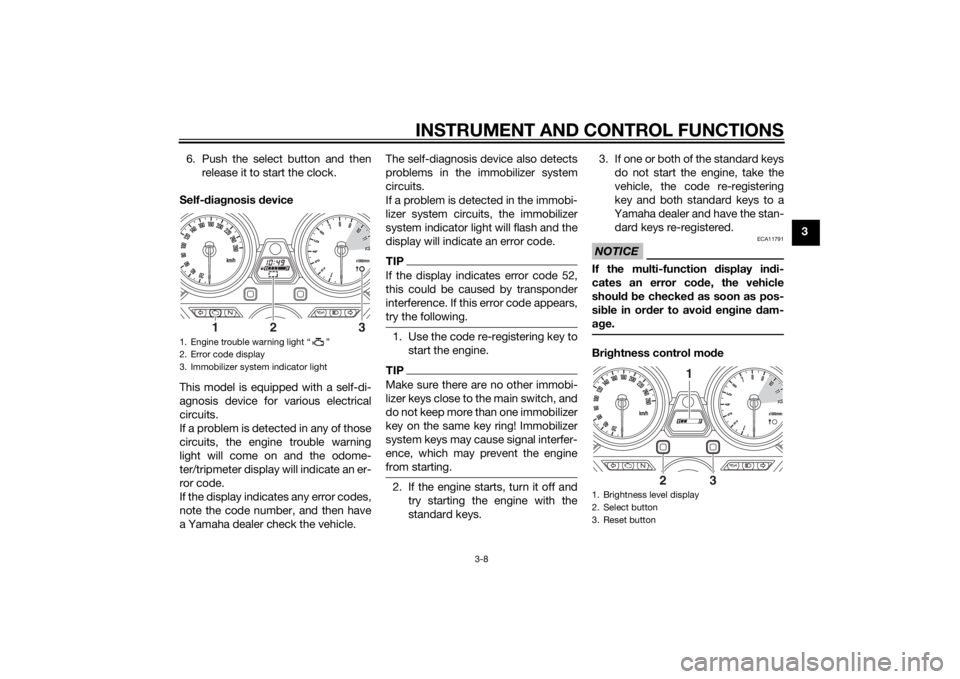
INSTRUMENT AND CONTROL FUNCTIONS
3-8
3
6. Push the select button and then
release it to start the clock.
Self-d iagnosis device
This model is equipped with a self-di-
agnosis device for various electrical
circuits.
If a problem is detected in any of those
circuits, the engine trouble warning
light will come on and the odome-
ter/tripmeter display will indicate an er-
ror code.
If the display indicates any error codes,
note the code number, and then have
a Yamaha dealer check the vehicle. The self-diagnosis device also detects
problems in the immobilizer system
circuits.
If a problem is detected in the immobi-
lizer system circuits, the immobilizer
system indicator light will flash and the
display will indicate an error code.
TIPIf the display indicates error code 52,
this could be caused by transponder
interference. If this error code appears,
try the following.1. Use the code re-registering key to
start the engine.TIPMake sure there are no other immobi-
lizer keys close to the main switch, and
do not keep more than one immobilizer
key on the same key ring! Immobilizer
system keys may cause signal interfer-
ence, which may prevent the engine
from starting.2. If the engine starts, turn it off andtry starting the engine with the
standard keys. 3. If one or both of the standard keys
do not start the engine, take the
vehicle, the code re-registering
key and both standard keys to a
Yamaha dealer and have the stan- dard keys re-registered.
NOTICE
ECA11791
If the multi-function display in di-
cates an error co de, the vehicle
shoul d b e checked as soon as pos-
si ble in or der to avoi d en gine dam-
a g e.Brig htness control mo de
1. Engine trouble warning light “ ”
2. Error code display
3. Immobilizer system indicator light
1
2
3
1. Brightness level display
2. Select button
3. Reset button
1
2
3
U2PNE0E0.book Page 8 Tuesday, September 16, 2014 4:15 PM